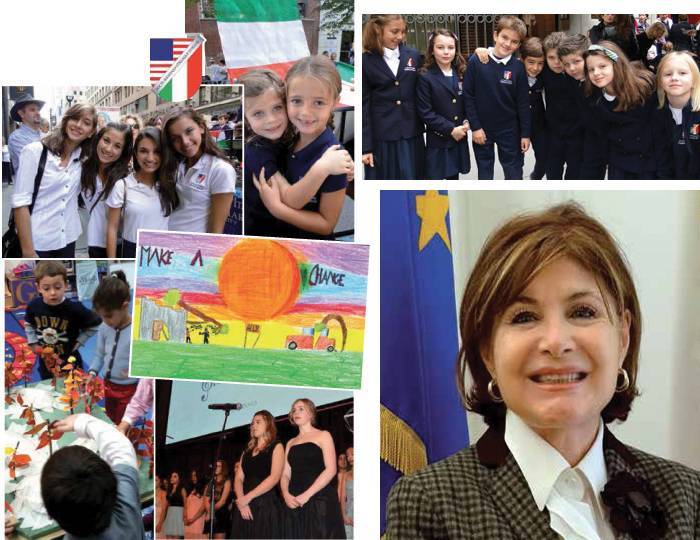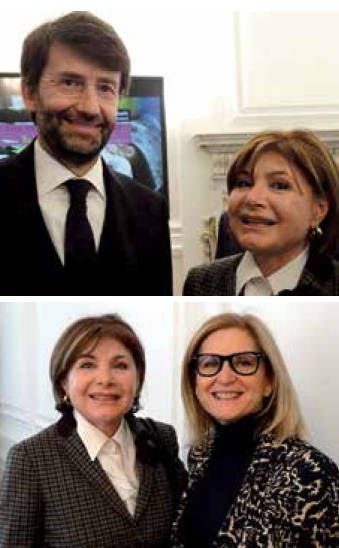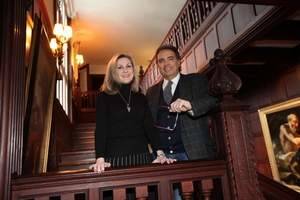Building the Future Today
You notice it immediately upon entering the building, upon standing in the halls of the only bilingual Italian school in New York. This is a place that fosters collaboration and participation, a place where friendly interactions and mutual support between students, parents, teachers and staff are paramount.
The school that provides a real sense of community raises the potential for an appreciation of
the collective, of us—too often overwhelmed in today’s world by individualism and hyper-productivity—without sacrificing the power of me. It promotes an almost familial sense of belonging, a characteristic feature of Italian cultural heritage.
Such a feeling helps students view the future with realistic optimism and prepares them for a life that starts here, at school, without isolating themselves and others. School, family and local community are not separate entities. Understanding their linkage is fundamental, even more so in New York, where multitudes of different worlds exist.
I find this preamble necessary for explaining why I’ve decided to take a look at New York’s Scuola d’Italia “Guglielmo Marconi” through the eyes of one of its former students and current board members. Despite significant obstacles, the school board has decided to take another leap toward improving the institution.
As President Steve Acunto announced in an official statement, Scuola d’Italia “has undertaken steps toward the purchase of a property in Manhattan that will give [them] 100,000 plus square feet.
The area of the facility is 3-4 times as large as [their] present total square footage and will be built to offer a greatly improved, far more advanced school facility to accommodate the top competitive prep school that [they] envision.” If all goes as planned, the deal will be closed this summer.
Dr. Francesca Verga, a surgeon in New York, sat down with us to talk about the past, present and future of an institution that is vital to keeping Italian culture alive—a school that stands to become a leading light in global education.
Discovering a tiny little school
But first a little about Dr. Verga. “I never thought I would live in New York,” she says. “I was raised in Rome. I really wanted to become a doctor. I met my husband, a French-Italian, when he was a medical student. He wanted to specialize in plastic surgery in the US. At the time, that possibility didn’t exist in Europe, so he came here and I went with him.”
In 1976, the young wife faced many obstacles on the road to becoming a doctor. As an Italian, she couldn’t obtain a loan to study in the US. In order to study medicine in Italy, she had to have a high school degree from a scientific institute. That’s when she discovered a small Italian school in New York, where, in 1978, she obtained her degree. The doors swung open. Verga entered a school of medicine in Italy, which she successfully completed while traveling back and forth from Rome to New York.
“The school was tiny! It was impossible to imagine the headway it would make. We have to thank the foresight of Ambassador Alessandro Cortese de Bosis. I’d get to school in the morning and it was like being greeted by a real family. There were students of all ages, Italian Americans facing the same issue: how to obtain a degree that allowed them to study in Italy.”
The first steps
Slowly but surely, the school began to grow. First located between Park and Madison, it later moved into the Church of Our Lady of Pompeii. When Verga’s 14-year-old brother came to New York, he too enrolled in the school. “That’s how I stayed in touch with what had become my second family. I was there through all of its problems, especially its financial problems. It wasn’t in a position to compete with other schools back then, even though its student body kept growing.”
Scuola d’Italia made its first major breakthrough when it purchased a building on 96th Street. But the turning point, according to Verga, occurred when Maria Bianca Padolecchia took over as headmistress. “The school was on equal standing with Italian state schools, but it had yet to meet the standards of independent schools in America. Maria Bianca understood that second step was crucial. Scuola d’Italia needed recognition from the Board of Regents of the State of New York. And she succeeded in getting it. For those who come to study at Scuola d’Italia today, it’s as if they were studying at an American school. At the same time, they have the real privilege of attending a bilingual and bicultural school.”
Providing a global education
For years now, Verga has been an effective and fervent participant in the life of the school. “I’m grateful to the school for helping me maintain contact with Italy. When I was a student, there was no telephone, no Internet, and Italy was far away. Thanks to the school, I not only succeeded in becoming a doctor. I also remained close to my country.”
Meanwhile the school continues to grow, and as it grows, it changes. No longer exclusive to the children of Italian diplomats and professionals temporarily living in New York, the school boasts an important international presence now. “It’s a school for everyone,” says Verga. “It promises and provides a global education. It’s not a school for the future, but a school for building the future today.” Hence the board’s efforts to increase the school’s standing on a European level. There will be a third language, and the NSERC BBA International must be obtained to allow the students to gain access to the best universities around the world.”
“We have to aim high”
Besides being a member of the board, Verga has long overseen the school’s annual gala, promoted its image, and helped with fundraising. Nowadays fundraising is not only about raising money for technological improvements and scholarships. “Capital campaigning” requires finding funds to acquire larger spaces to make a school truly competitive by expanding its educational program and enrolling more students.
Today the school has 300 students, but the number of applicants continues to rise. “We have to go forward with a new building for today’s students and tomorrow’s. If we stop now, we’ll be taking a step backward… Instead,” continues Verga. “We have to aim high. We have to keep sending students to the best universities in the world. We face global challenges today and a school like ours can be extremely important for facing them.”
The recent developments augur an important step forward not only for the school, but also for Italy’s image. Once the Scuola d’Italia in New York has been consolidated, says Verga, other schools with the same educational model will open, satellite schools that will also disseminate Italian culture. “I was struck by the fact,” she concludes, “that the French President spent three hours in New York’s French school.
My dream is that when the President of the Republic or the Prime Minister of Italy is abroad, he will make use of the School’s facilities. Italians living abroad are an asset to our country and are valued throughout the world.”




































i-Italy
Facebook
Google+
This work may not be reproduced, in whole or in part, without prior written permission.
Questo lavoro non può essere riprodotto, in tutto o in parte, senza permesso scritto.